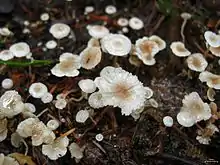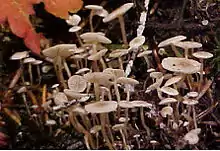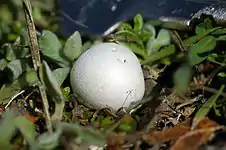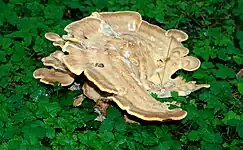| Collybia cirrhata | |
|---|---|
 | |
| Scientific classification | |
| Domain: | Eukaryota |
| Kingdom: | Fungi |
| Division: | Basidiomycota |
| Class: | Agaricomycetes |
| Order: | Agaricales |
| Family: | Tricholomataceae |
| Genus: | Collybia |
| Species: | C. cirrhata |
| Binomial name | |
| Collybia cirrhata | |
| Synonyms[1][2] | |
|
Agaricus amanitae Batsch (1786) | |
| Collybia cirrhata | |
|---|---|
| Gills on hymenium | |
| Cap is convex or flat | |
| Hymenium is adnate | |
| Stipe is bare | |
| Spore print is white | |
| Ecology is saprotrophic | |
| Edibility is unknown | |
Collybia cirrhata is a species of fungus in the family Tricholomataceae of the order Agaricales (gilled mushrooms). The species was first described in the scientific literature in 1786, but was not validly named until 1803. Found in Europe, Northern Eurasia, and North America, it is known from temperate, boreal, and alpine or arctic habitats. It is a saprobic species that grows in clusters on the decaying or blackened remains of other mushrooms. The fruit bodies are small, with whitish convex to flattened caps up to 11 mm (3⁄8 in) in diameter, narrow white gills, and slender whitish stems 8–25 mm (3⁄8–1 in) long and up to 2 mm (0.08 in) thick. C. cirrhata can be distinguished from the other two members of Collybia by the absence of a sclerotium at the base of the stem. The mushroom is of unknown edibility.
Taxonomy and phylogeny
| ||||||||||||||||||||||||||||||||||||||||||
| Phylogeny and relationships of C. cirrhata and closely related fungi based on ribosomal DNA sequences.[3] |
The species first appeared in the scientific literature in 1786 as Agaricus amanitae by August Johann Georg Karl Batsch;[4] Agaricus amanitae subsp. cirrhatus, proposed by Christian Hendrik Persoon in 1800,[5] is considered synonymous.[2] A later combination based on this name, Collybia amanitae, was published by Hanns Kreisel in 1987.[6] However, Kreisel noted the combination to be "ined.",[7] indicating that he did not believe the name to be validly published, according to article 34.1 of the rules for botanical nomenclature, which states: "A name is not validly published ... when it is not accepted by the author in the original publication."[8]
The first valid name was published in 1803 by Heinrich Christian Friedrich Schumacher, who called the species Agaricus cirrhatus.[9] French mycologist Lucien Quélet transferred it to Collybia in 1879,[10] resulting in the binomial by which it is currently known. The species had also been transferred to Microcollybia by Georges Métrod in 1952[11] and again by Lennox in 1979 (because Métrod's transfer was considered a nomen nudum, and thus invalid according to nomenclatural rules);[12] the genus Microcollybia has since been wrapped into Collybia.[13]
Molecular phylogenetics have shown that C. cirrhata forms a monophyletic clade with the remaining two species of Collybia. Because C. cirrhata is the only one of the three Collybia species lacking sclerotia, it has been suggested that this character trait is an anapomorphy—that is, unique to a single, terminal species within a clade.[3]
The specific epithet is derived from the Latin cirrata, meaning "curled".[14] Charles Horton Peck called it the "fringed-rooted Collybia".[15] In the United Kingdom, it is commonly known as the "piggyback shanklet".[16]
Description

The cap is initially convex when young, later becoming convex to flattened or slightly depressed in the center, reaching a diameter of 3–11 mm (1⁄8–3⁄8 in). The cap margin starts out rolled or curved inward, but straightens out as it matures. The cap surface ranges from dry to moist, smooth to covered with fine whitish hairs, and is mostly even with translucent radial grooves at the margin. It is subhygrophanous (changing color somewhat depending on hydration), becoming a grayish-orange when watery or old, and usually is white with a very faint pinkish flush when fresh. The flesh is whitish, quite thin, and has no distinctive taste or odor. The gills are adnate to slightly arcuate (curved into the shape of a bow) with a tooth (meaning that the gills curve up to join the stem but then, very close to the stem, the gill edge curves down again).[17] There are between 12 and 20 gills that extend completely from the cap edge to the stem, and three to five tiers of lamellulae (shorter gills that do not extend completely from the cap edge to the stem).[7] The gills are thin, narrow to moderately broad, and white to pinkish-buff. The gill edges are even, and the same color as the gill faces.[18]
The stem is 8–25 mm (3⁄8–1 in) long and up to 2 mm (1⁄16 in) thick, equal in width throughout to slightly enlarged downward, flexible and filamentous but not fragile. The stem surface is dry, whitish to grayish-orange, sometimes with tiny hairs on the upper portion that become coarser near the base. The stem base often has rhizomorph-like strands or copious whitish mycelia. The stem, unlike the other two species of Collybia, do not originate from a sclerotium. The stem becomes hollow as it matures.[18] C. cirrhata is too small and insubstantial to be considered edible.[17]
Microscopic characteristics
In deposit, the spores appear white.[7] Individual spores are ellipsoid to tear-shaped in profile, obovoid to ellipsoid or roughly cylindric in face or back view, with dimensions of 4.8–6.4 by 2–2.8 (sometimes up to 3.5) µm. They are smooth, inamyloid, and acyanophilous (unreactive to staining with Melzer's reagent and methyl blue, respectively). The basidia (spore-bearing cells of the hymenium) are roughly club-shaped, four-spored, and measure 17.5–21 by 4.8–5.6 µm. The gills do not have cystidia. The gill tissue is made of hyphae that are interwoven to roughly parallel, and inamyloid. The hyphae are 2.8–8.4 µm in diameter and smooth. The cap tissue is made of interwoven hyphae beneath the center of the cap, but radially oriented over the gills; it too is inamyloid. These hyphae are 3.5–8.4 µm in diameter, smooth, but have irregularly thickened walls. The cap cuticle is an ixocutis—a gelatinized layer of hyphae lying parallel to the cap surface. The hyphae comprising this layer are 2.8–6.4 µm in diameter, smooth, and thin-walled. They are covered with scattered, short pouch-like outgrowths. The cuticle of the stem is a layer of parallel, vertically oriented hyphae; the hyphae measure 3.5–4.2 µm, and are smooth, slightly thick-walled, and pale yellowish-brown in alkaline solution. They give rise to a covering of tangled and branched caulocystidia (cystidia on the stem) that have multiple septa. The caulocystidia are 2.8–4.8 µm in diameter, smooth, thin walled, and shaped like contorted cylinders. Clamp connections are present in the hyphae of all tissues.[18]
Similar species
Collybia cirrhata is most likely to be confused with the remaining members of Collybia, which have a similar external appearance. C. tuberosa is distinguished by its dark reddish-brown sclerotia that resemble apple seeds, while C. cookei has wrinkled, often irregularly shaped sclerotia that are pale yellow to orange.[19] Other similar mushrooms include Baeospora myosura and species of Strobilurus,[20] but these species only grow on pine cones.
Habitat and distribution


Like all species remaining in the genus Collybia, C. cirrhata is saprobic, and is typically found growing on the decaying or blackened remains of other mushrooms;[19] occasionally the fruit bodies may be found growing on moss or soil without any apparent connection to decaying mushrooms,[21] although these observations may represent instances where the remnant host tissue—possibly from a previous season—has decayed to such an extent that it remains as buried fragments in the substrate.[3] Known hosts include Lactarius, Russula, Meripilus giganteus, and Bovista dermoxantha.[7][22]
Collybia cirrhata is known from temperate, boreal, and alpine or arctic habitats. The fungus is widespread in Europe,[23] including Bulgaria,[24] Denmark,[25] Germany,[26] Greece,[21] Latvia,[27] Scandinavia,[28] Slovakia,[29] Switzerland,[22] Turkey,[30] and the United Kingdom.[31] The mushroom is also common in northern montane regions of North America.[19] In Asia, the fungus has been reported in Korea,[32] and in Hokkaido, northern Japan. It is also known from Greenland.[22] A 2009 publication suggested that based on the known evidence, the species' distribution may be circumboreal.[7]
References
- ↑ "Collybia cirrhata (Schumach.) Quél". Species Fungorum. International Mycological Association. Retrieved 2011-01-02.
- 1 2 "Collybia cirrhata (Schumach.) Quél. 1872". MycoBank. International Mycological Association. Retrieved 2010-12-19.
- 1 2 3 Hughes KW, Petersen RH, Johnson JE, Moncalvo J-E, Vilgalys R, Redhead SA, Thomas T, McGhee LL (2001). "Infragenic phylogeny of Collybia s. str. based on sequences of ribosomal ITS and LSU regions". Mycological Research. 105 (2): 164–72. doi:10.1017/S0953756200003415.
- ↑ Batsch AJGK. (1786). Elenchus fungorum. Continuatio prima (in Latin and German). p. 109. Archived from the original on 2019-01-20. Retrieved 2011-01-03.
- ↑ Persoon CH. (1799). Observationes Mycologicae (in Latin). Vol. 2. Leipzig. p. 53.
- ↑ Kreisel H. (1987). Pilzflora der Deutschen Demokratischen Republik (in German). Gustav Fischer Verlag Jena. p. 47. ISBN 978-3-334-00025-0.
- 1 2 3 4 5 Kasuya T, Sato S (2009). "Fructification of Collybia cirrata on mummified gleba of Bovista dermoxantha in Hokkaido, Northern Japan". Mycotaxon. 107: 81–86. doi:10.5248/107.81.
- ↑ "Division II. Rules and Recommendations. Chapter IV. Effective and Valid Publication Section 2. Conditions and Dates of Valid Publication of Names". International Code of Botanical Nomenclature (Vienna code). International Association for Plant Taxonomy. 2006. Retrieved 2011-01-02.
- ↑ Schumacher HCF. (1801). Enumeratio Plantarum, in Partibus Sællandiae Septentrionalis et Orientalis Crescentium (in Latin). p. 308.
- ↑ Quélet L. (1872). "Les Champignons de Jura et des Vosges". Mémoires de la Société d'Émulation de Montbéliard. II (in French). 5: 96.
- ↑ Métrod G. (1952). "Les Collybies". Revue de Mycologie (in French). 17: 60–93.
- ↑ Lennox JW. (1979). "Collybioid genera in the Pacific Northwest". Mycotaxon. 9 (1): 117–231.
- ↑ Kirk PM, Cannon PF, Minter DW, Stalpers JA (2008). Dictionary of the Fungi (10th ed.). Wallingford, UK: CABI. p. 424. ISBN 978-0-85199-826-8.
- ↑ Rea C. (1922). British Basidiomycetae: a Handbook to the Larger British Fungi. Cambridge, UK: Cambridge University Press. p. 334.
- ↑ Peck CH. (1896). "Report". Annual Report of the State Botanist of the State of New York. 55: 41.
- ↑ "Recommended English Names for Fungi in the UK" (PDF). British Mycological Society. Archived from the original (PDF) on 2011-07-16. Retrieved 2010-09-24.
- 1 2 Miller HR, Miller OK (2006). North American Mushrooms: a Field Guide to Edible and Inedible Fungi. Guilford, Connecticut: Falcon Guide. p. 136. ISBN 0-7627-3109-5.
- 1 2 3 Halling RE (14 July 2009). "Collybia sensu stricto". A revision of Collybia s.l. in the northeastern United States & adjacent Canada. Retrieved 2010-12-20.
- 1 2 3 Kuo M. (August 2003). "Collybia cirrhata". MushroomExpert.Com. Retrieved 2010-12-20.
- ↑ Trudell S, Ammirati J (2009). Mushrooms of the Pacific Northwest. Timber Press Field Guides. Portland, Oregon: Timber Press. p. 116. ISBN 978-0-88192-935-5.
- 1 2 Dimou DM, Zervakis GI, Polemis E (2008). "Mycodiversity studies in selected ecosystems of Greece: IV. Macrofungi from Abies cephalonica forests and other intermixed tree species (Oxya Mt., central Greece): Supplementary material" (PDF). Mycotaxon. 104: 1–52.
- 1 2 3 Hughes KW, Peterson RH (2006). "Relationships among Collybia s. str. from Greenland, North America and Eurasia". Meddelelser om Grønland. 56: 99–105. ISBN 9788763512770.
- ↑ Noordeloos ME. (1995). "Collybia". In Bas C, Kuyper Th W, Noordeloos ME, Vellinga EC, van Os J (eds.). Flora Agaricina Neerlandica. Vol. 3. Boca Raton, Florida: CRC Press. pp. 106–23. ISBN 90-5410-616-6.
- ↑ Denchev CM, Assyov B (2010). "Checklist of the larger basidiomycetes in Bulgaria". Mycotaxon. 111: 279–82. doi:10.5248/111.279.
- ↑ "Silke-Fladhat (Collybia cirrhata) - Foto/billede fra Mogenstrup Gl. Grusgrav taget af Hanne Farnæs". Fugleognatur.dk. Retrieved 2011-01-02.
- ↑ Gerhardt E. (1990). "Checkliste der Großpilze von Berlin (West) 1970-1990". Englera (13): 3–5, 7–251. doi:10.2307/3776760. JSTOR 3776760. (subscription required)
- ↑ Kļaviņš A. "Collybia cirrhata (I. H. Schum.) P. Kumm". Latvijas Daba. Retrieved 2011-01-02.
- ↑ Papetti CEG. (1999). "Scandinavia: sulle orme dei grandi naturalisti nordici, a contatto con una natura incontaminata – Parte I" [Scandinavia: in the footsteps of the great Nordic naturalists, in touch with uncontaminated nature – Part I]. Rivista di Micologia (in Italian). 42 (2): 119–39. ISSN 0394-9486.
- ↑ Baranovič R. (2008). "Peniazovka štetinkatá Collybia cirrhata (Schumach.) P. Kumm". www.nahuby.sk. Retrieved 2011-01-02.
- ↑ Yağiz D, Afyon A (2005). "The macrofungi of Karabük Province" (PDF). Turkish Journal of Botany. 29: 345 53. Archived from the original (PDF) on 2019-01-20. Retrieved 2011-01-03.
- ↑ "NBN Gateway: Piggyback Shanklet (Collybia cirrhata) grid map". National Biodiversity Network. Retrieved 2011-01-02.
- ↑ Kim Y-S, Seok S-J, Park Y-H, Cha D-Y, Min K-H, Yoo K-H (1994). "Fungal flora of Mt. Chiak (I): Agaric fungi". Korean Journal of Mycology. 22 (4): 410–20. ISSN 0253-651X.